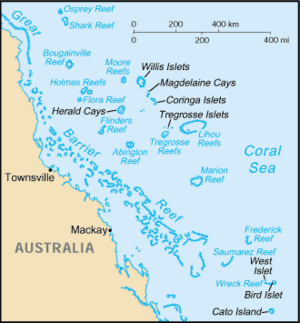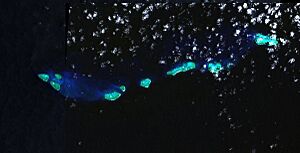Wreck Reefs facts for kids
The Wreck Reefs are a group of reefs and small islands in the southern part of the Coral Sea Islands. They are about 450 kilometers (280 miles) northeast of Gladstone, Queensland, Australia. This chain of reefs stretches for about 25 kilometers (15.5 miles) from west to east.
Some small islands, called cays, can be found on these reefs. These include Bird Islet, West Islet, and Porpoise Cay.
The reefs got their name because two ships, HMS Porpoise and Cato, were lost here in 1803. Matthew Flinders, a famous explorer, was a passenger on the Porpoise when it hit the reefs. The area is now protected as a historic shipwreck site.
Contents
About Wreck Reefs
The Wreck Reefs are located about 100 kilometers (62 miles) southeast of Kenn Reefs and 120 kilometers (75 miles) north of Cato Island.
This group of reefs forms a narrow chain, about 25 kilometers (15.5 miles) long and 5 kilometers (3 miles) wide. It covers an area of 75 square kilometers (29 square miles) and is open towards the north. The ocean waves always break over the small islands (cays) here.
The coral reefs sit on top of a large shield volcano. This volcano was formed by eruptions from the Tasmantid Seamount Chain.
Islands on the Reefs
Several small islands, or cays, are part of the Wreck Reefs:
- Bird Islet 22°10′S 155°28′E / 22.167°S 155.467°E is about 500 meters (1,640 feet) long and 250 meters (820 feet) wide. It stands about 6 meters (20 feet) high. The center of the islet is bare, but a ring of plants grows around it. It is the only island in the chain with a lot of plants. Its reef extends for 4.5 kilometers (2.8 miles).
- Porpoise Cay is 275 meters (900 feet) long, 90 meters (300 feet) wide, and 3 meters (10 feet) high. It has a few small plants. This cay is located 11 kilometers (6.8 miles) west of Bird Islet, in the middle of a shallow lagoon. The reef around it can be seen when the tide is low.
- West Islet 22°12′S 155°10′E / 22.200°S 155.167°E is 1.8 meters (6 feet) high and has no plants. It is near the center of three separate reefs at the western end of Wreck Reefs. A reef that is mostly underwater surrounds West Islet.
History of Wreck Reefs
Shipwrecks and Discovery
In 1803, Matthew Flinders was leaving Port Jackson (modern-day Sydney) for the last time. He was on HMS Porpoise, traveling with two other ships, Cato and Bridgewater. On August 17, disaster struck. The Porpoise and Cato hit the uncharted Wreck Reefs. The Bridgewater sailed away, leaving them behind.
When the Porpoise hit the reef, it tilted sharply, but luckily, it fell towards the reef, saving the people on board. The Cato hit about 360 meters (1,200 feet) away and quickly broke apart. Several sailors were hurt, and three young boys drowned. One boy, who had been shipwrecked many times before, sadly lost his grip and was swept away.
The shipwrecked sailors managed to reach a dry sandy area in the middle of the reef. They set up a camp. While looking for firewood, they found old ship parts. Flinders thought they might be from one of Lapérouse's ships, but those wrecks were later found elsewhere. Some people now think the parts might have come from a long-lost Spanish ship or an American whaling ship.
Flinders and 13 others, including Captain Parker, decided to row back to Sydney in the ship's small boat, which they named "Hope." They left on August 26. Governor King in Sydney sent rescue ships: Rolla and two smaller schooners, HMS Cumberland and Francis. Flinders returned to Wreck Reefs on September 29, bringing relief to the stranded crews.
During Flinders's absence, some of his officers built a small ship called Resource. The shipwrecked crews were then divided among the four ships. Some went back to Sydney, while others sailed to China and then to Europe. Matthew Flinders himself sailed on the small schooner Cumberland to England, but he was forced to stop at Mauritius, where the French held him for seven and a half years.
Guano Mining on Bird Islet
In the 1860s, people started mining guano (bird droppings) on Bird Islet. Guano is a very good natural fertilizer for plants. The British government gave a company called the Anglo-Australian Guano Company the right to collect guano from several islands, including Bird Islet.
Bird Islet was a coral island about 1.6 kilometers (1 mile) around, rising about 3.6 meters (12 feet) above the sea. It was covered with high-quality guano. The company worked there for many years, removing thousands of tons of guano. They usually stopped operations during the summer because of hurricanes.
The guano from Bird Islet was very popular in Tasmania, where it was used to make farm soil richer. Workers said it had an ammonia smell but was considered healthy.
There were two types of guano:
- Alluvial guano was a softer, older layer.
- Rock guano was harder, like stone, and had to be dug out and crushed. This type was richer because rainwater had washed nutrients from the top layers down into it, making it solidify over time.
The depth of the guano on the island was about 1.6 meters (5.5 feet). Below each layer of guano was a layer of sand. It was believed that guano islands formed over many years. Birds would leave droppings on coral rock, creating a layer of guano. Then, a hurricane would cover it with sand. More birds would come, add more guano, and another hurricane would add more sand. This process made the island grow taller and created many layers of guano.
The guano from Bird Islet was preferred over guano from other islands. The company planned to improve the mooring area so ships could safely load the guano.
Known Shipwrecks on Wreck Reefs
Many ships have been lost on the Wreck Reefs over the years. Here are some of the known ones:
- Cato: This ship was lost along with the Porpoise in 1803.
- Porpoise: This ship, carrying Matthew Flinders, was wrecked in 1803.
* In 1965, after a lot of research, divers Ben Cropp and Jiri Hrbac found the wreck sites of both the Cato and Porpoise.
- Marcia: This schooner returned to Wreck Reef in April 1804 to try and salvage items from the Porpoise and Cato.
- Lion: The American whaling ship Lion was lost on Wreck Reef on December 4, 1856. The crew of 40 people managed to escape in five small boats and were later rescued.
- Lone Star: On September 10, 1870, the schooner Lone Star hit Wreck Reef and became a total wreck within an hour. The crew from the whaling station on Bird Island helped save some of her equipment.



